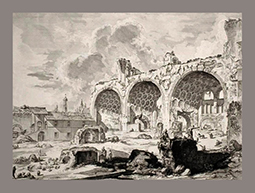Authors: C. di Fazio, A. Grazian
Download article as .pdf.: La Velia da Massenzio a Mussolini. Ideologia, politica e paesaggio urbano

The contribution intends to analyse, investigating the ideological meanings in terms of urban policy, the long-term events that since the age of Maxentius have followed one another in the urban history of the southern slope of the Velia, one of the most representative and historically qualified areas of the centre of Ancient and modern Rome. The hill has been the object of successive transformations that have changed the image and value of this important public space up to the contemporary age. After the late ancient and medieval phases, the functional alterations of the area were followed by the loss of identity of the basilica of Maxentius, recognized as such only in the early 19th century by Antonio Nibby. The views, engravings and drawings from the 17th-19th centuries witness the evolution of the urban image of this part of the city, replaced in the role of symbolic centre by the new focal points of papal Rome. A renewed chapter in the history of the southern slope of the Velia opened up with the French government’s urban policy projects (1809-1814), followed by the 19th-century excavations and then by the idea of the “passeggiata archeologica” which has polarised the archaeological debate and urban planning of the post-unitary period. Finally, the opening of via dell’Impero was the last act of semantization of this sector of the Velia, according to an ideological and propagandist urban policy process that has directly involved the basilica of Maxentius, reinterpreting it in its functions.
